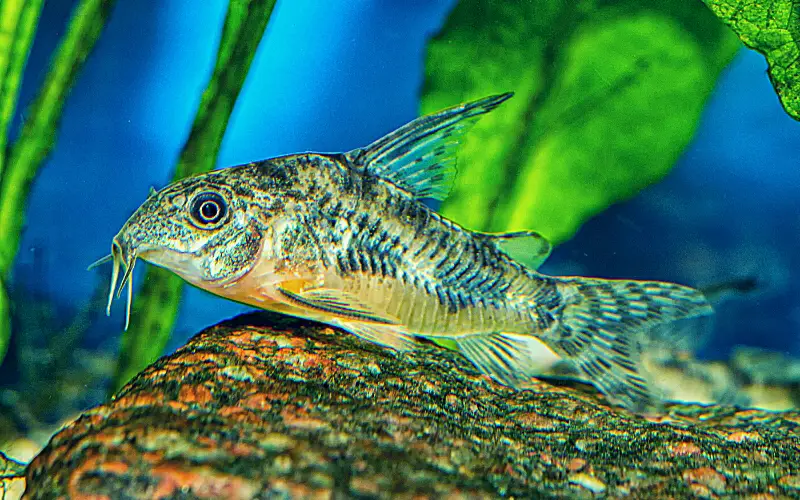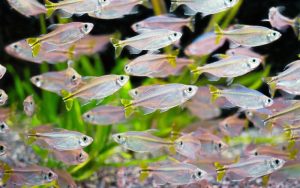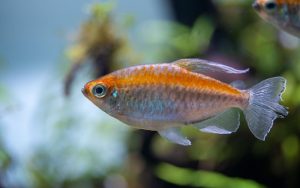Corydoras catfish and bettas are popular choices for most beginner aquarists. Both species have unique dietary requirements, with bettas being carnivorous and Cory catfish being omnivorous. This often leads to the question: can Cory catfish eat betta food? The answer is not as straightforward as it seems.
While Cory catfish are known to scavenge for leftover betta food in the tank, it is not their ideal diet. Feeding them betta food exclusively can lead to nutritional deficiencies and health issues in the long run. However, some aquarists argue that occasional consumption of betta food may not harm cory catfish.
In this article, we will delve deeper into the dietary needs of both cory catfish and bettas, exploring the potential risks and benefits of feeding them the same food. We will also provide alternative feeding options for cory catfish to ensure their optimal health and well-being. So, is betta food deadly or delicious for cory catfish? Let’s find out.
Table of Contents
ToggleCan Betta Fish And Cory Catfish Live Together?
Betta fish and cory catfish can potentially live together in the same tank, but there are specific considerations to keep in mind.
Betta fish are known to be territorial and aggressive, especially towards other male bettas, so it’s essential to carefully monitor their behavior when introducing them to the tank with Cory catfish.
The best way to ensure peaceful cohabitation is to provide enough hiding spots and plants to break up their line of sight, allowing each species to have its own space.
It’s also essential to monitor the betta’s behavior and have a backup plan in case they become too aggressive towards the corys catfish.
Additionally, it’s essential to monitor the tank’s water quality carefully and ensure that both species are compatible regarding water parameters and diet. With the proper precautions and observance, betta fish and cory catfish can live harmoniously in the same aquarium.
Can Cory Catfish Eat Betta Food?
Can Corydoras eat betta food? While Cory catfish can technically eat betta food, it is not their ideal diet. Here’s why:
Betta food is designed for carnivores, while Cory catfish are omnivores. Betta food is typically high in protein and fat, which may not provide the necessary nutrients for Cory catfish, which require a balanced diet of protein, vegetables, and algae.
Betta’s food is often floating pellets, while Cory’s catfish are bottom feeders. This means they struggle to compete with the betta for food, potentially leading to malnutrition and health issues.
Here are some better food options for Cory catfish:
- Sinking pellets or wafers specifically formulated for Cory catfish: These bottom feeder tablets are designed to be nutritious and dissolve slowly, allowing the Cory catfish to eat at their own pace.
- Live foods: Cory catfish enjoy bloodworms, brine shrimp, and daphnia. These live foods provide them with essential protein and nutrients.
- Algae wafers: Cory catfish will also eat algae wafers, which provide your cory catfish with vitamins and fiber.
Here are some tips for feeding Cory, catfish in a tank with a betta:
- Feed the Cory catfish first: Feed them their sinking food before feeding the betta. This will allow them to eat their food without competing with the betta.
- Feed the betta in a separate container: You can use a feeding cup or breeder box to feed the betta its food. This will prevent it from eating the Cory catfish’s food.
- Provide plenty of hiding places: Cory catfish are shy and need hiding places in the tank. This will help them feel safe and secure and make it easier for them to eat without being harassed by the betta.
Overall, while Cory catfish can eat betta food, it is not their best diet. By providing them with a balanced diet of sinking pellets, live food, and algae wafers, you can help them thrive.
Habitats for Corydoras and Bettas
Corydoras, also known as Cory catfish, are found in the freshwater habitats of South America, particularly in the Amazon River basin. They thrive in areas with slow-moving water, enough food, and soft substrate.
Corydoras are bottom-dwelling fish and prefer habitats with hiding spots such as rocks, driftwood, and plants. They also shoal fish and like to be kept in groups of at least 6 individuals. On the other hand, Bettas are native to the rice paddies and slow-moving streams of Southeast Asia.

Thanks to a specialized organ called the labyrinth, they are known for their ability to breathe air from the surface. Betta habitats in the wild have warm, stagnant water with plenty of plants and floating debris, which provide them with cover and resting spots.
When kept in captivity, it’s essential to provide Bettas with a tank that mimics their natural habitat, with live plants, gentle filtration, and warm water. Corydoras and Bettas require clean, well-maintained aquariums with suitable water parameters to thrive and live a healthy life.
What do Corydoras Eat?
Corydoras are omnivorous scavengers that will eat various foods in the aquarium. Their diet primarily consists of small crustaceans, worms, and insect larvae that they find on the substrate as they sift through the bottom of the tank.
In captivity, they can be fed a diet of high-quality flake or pellet food and frozen or live foods such as bloodworms, brine shrimp, and daphnia. They also benefit from occasional vegetable matter such as blanched zucchini or cucumber.
It is crucial to provide a varied diet to ensure Corydoras receive all the essential nutrients they need for good health and vitality. Overfeeding should be avoided as it might lead to health problems and water quality issues in the aquarium.
Ideal Dietary Requirements for Betta Fish
Betta fish are naturally predatory, meaning their diet should consist primarily of meat-based foods. However, they also benefit from some plant-based matter for a well-rounded diet. Here’s a breakdown of their ideal dietary requirements:
Main Components:
- Protein: Betta fish require a high protein diet, around 35%. This protein should come from a mix of animal and plant sources.
- Animal-based protein: This can include betta pellets designed explicitly for betta fish, freeze-dried bloodworms, brine shrimp, daphnia, mosquito larvae, and tubifex worms.
- Plant-based protein: Spirulina flakes and algae wafers can provide essential nutrients and fiber.
- Fat: Fish need a small amount of fat for energy and to absorb vitamins. Sources include live and frozen foods like brine shrimp, daphnia, and bloodworms.
Tank Conditions for Corydoras
The tank conditions for Corydoras, also known as Cory catfish, are relatively easy to maintain. These small, peaceful fish prefer a tank with a soft, sandy substrate to mimic their natural habitat. They also require plenty of hiding spots, such as caves, driftwood, and plants, to feel secure.
The tank should be well-filtered, and regular water changes are essential as Corydoras are sensitive to poor water quality. The tank should be between 72 and 79°F (22 and 26°C), with a slightly acidic to neutral pH of 6.5 to 7.5.
Providing adequate lighting is essential, but be cautious not to have too much direct light as it may cause algae overgrowth.
Corydoras are shoaling fish and should be kept in small groups of at least 3-5 individuals. They are not aggressive and can be housed with other peaceful fish of similar size and temperament. Maintaining Corydoras tank conditions involves creating a well-structured and clean environment that mimics their natural habitat.
A Well-Balanced Betta Fish And Cory Catfish Diets
To maintain a well-balanced diet for betta fish and Cory catfish, it is essential to provide them with various foods. Betta fish are carnivorous and thrive on a diet rich in high-quality fish pellets, frozen or live bloodworms, brine shrimp, and daphnia.
It is essential to ensure that their diet includes plenty of protein to keep them healthy and vibrant. On the other hand, Cory catfish are omnivores.
They will benefit from a diet of sinking algae wafers, shrimp pellets, and occasional live or frozen foods such as bloodworms or brine shrimp. It is essential to avoid overfeeding both species, as this can lead to health problems and decreased water quality in the aquarium.
Additionally, offering a variety of foods will help ensure that the betta fish and Cory catfish receive a well-rounded diet that meets all their nutritional needs.
Here is a table summarizing the dietary needs of betta fish and Cory catfish:
| Nutrient | Betta Fish | Cory Catfish |
|---|---|---|
| Protein | High | Moderate |
| Fat | Low | Moderate |
| Fiber | Low | High |
| Vitamins and Minerals | Essential | Essential |
Provide them with enough food: By following these guidelines, you can provide your betta fish and Cory catfish with a well-balanced diet to help them thrive.
How Much Do I Feed My Corydoras Catfish?
The amount of food you should feed your Corydoras Catfish depends on several factors, including:
Number of fish: The more Corydoras you have, the more food you will need to provide.
Size of the fish: Larger Corydoras will require more food than smaller ones.
Activity level: More active Corydoras will burn more energy and must be fed more frequently.
Water temperature: Warmer water temperatures can increase the metabolic rate of Corydoras, requiring them to eat more often.
Type of food: Different foods have different nutritional values, so you may need to adjust the amount you feed depending on what you give them.
General guidelines:
- Feed only what they can consume in 2-3 minutes, once or twice a day.
- Offer a variety of foods, including sinking pellets, algae wafers, and blanched vegetables.
- If you see uneaten food remaining after a few minutes, remove it to avoid water quality issues.
- Monitor your Corydoras closely and adjust their diet as needed.
Here are some additional tips for feeding your Corydoras Catfish:
- Fast your Corydoras once a week to help their digestion.
- Offer live or frozen foods occasionally as a treat.
- Avoid overfeeding, as this can lead to health problems.
- If you are unsure how much to feed your Corydoras, start with a small amount and increase it gradually until you find the right amount.
Commonly Asked Questions about Cory Catfish and Betta Diet (FAQs)
Can Cory catfish eat fish food?
can Corydoras eat betta food? Yes, Cory catfish can eat fish food, but they prefer sinking pellets or wafers designed for bottom feeders. They also enjoy frozen or live foods like bloodworms and brine shrimp.
Will Corydoras eat betta fish?
No, Corydoras are peaceful scavengers and won’t attack Bettas. However, individual Bettas might be aggressive towards Corydoras, so monitor their interactions and have a backup plan.
What do Cory catfish eat in the wild?
Corydoras eat a varied diet of bottom-dwelling insects, larvae, worms, and decaying plant matter in the wild. They also scavenge for leftover food from other fish.
Can catfish live with bettas?
Yes, certain catfish species like Corydoras can peacefully coexist with Bettas. They occupy different tank levels, have compatible temperaments, and share similar food preferences.
Are Corydoras good with bettas?
Yes, Corydoras catfish can be good tank mates for bettas. They are peaceful bottom-dwellers that generally coexist, adding diversity to the aquarium without significant compatibility issues.
Can you have a catfish with a betta fish?
Yes, some catfish species like Corydoras make great tank mates for Bettas. They are peaceful, occupy different tank levels, and share similar food preferences.
What fish can be in a tank with Cory catfish?
Cory catfish are compatible with peaceful tankmates such as tetras, guppies, and dwarf cichlids. Avoid aggressive or large fish. Provide a well-planted tank for hiding spots.
Do Cory catfish eat leftover food?
Yes, Cory catfish will eat leftover food, but it shouldn’t be their primary source of nutrition. They need a diet of sinking pellets, wafers, and algae supplements for complete health.
Do Cory catfish eat algae wafers?
Yes, Cory catfish will eat algae wafers, but it’s not their primary food source. They need a more balanced diet of sinking pellets and algae supplements for optimal health.
Can a bottom feeder live with a betta?
Yes, some bottom dwellers like Cory catfish and snails can live with bettas, but only in a large tank (10+ gallons) and with careful monitoring of their compatibility.
How to keep betta fish and Cory catfish together without harm?
To keep Betta fish and Cory catfish together peacefully, provide a spacious tank with hiding spots, maintain proper water conditions, and monitor their behavior. Avoid aggressive tank mates for Bettas.
Conclusion
So, can Cory catfish eat betta food? In conclusion, caring for your aquatic pets requires a thoughtful approach to their nutritional needs. While betta fish food is specifically formulated for bettas, it’s essential to consider the dietary requirements of other species, such as the Cory catfish. While they can tolerate various foods, a balanced diet is necessary for their health and well-being. So, while Cory catfish can eat betta food occasionally, it shouldn’t be their primary source of nutrition. Providing them with specialized catfish pellets and supplementing their diet with occasional treats will ensure their vitality and longevity. Remember, a happy and healthy aquarium ecosystem starts with proper feeding practices.
You might also like
- Cory Catfish and Betta: 5 Surprising Secrets for Success!
- 7 Best Cory Catfish Tank Mates for Ultimate Harmony!
- Best Food for Cory Catfish: 15 Picks for Optimal Health
- What Do Cory Catfish Eat in a Tank? (Corydoras Food List)
- Are Cory Catfish Aggressive: 5 Proven Ways to Tame Them!




